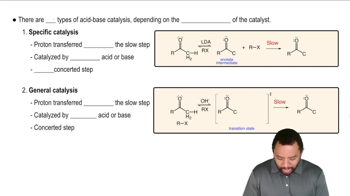Here are the essential concepts you must grasp in order to answer the question correctly.
Tautomerization
Tautomerization is a chemical process where a compound undergoes structural rearrangement, typically involving the migration of a hydrogen atom and a switch of a single bond and adjacent double bond. In the context of cyclohexa-1,4-diene, tautomerization involves the shift of double bonds to form cyclohexa-1,3-diene, which is facilitated by acidic conditions.
Recommended video:
Tautomerization Mechanisms
Acid Catalysis
Acid catalysis involves the use of an acid to increase the rate of a chemical reaction. In this mechanism, the acid donates a proton to the cyclohexa-1,4-diene, stabilizing the intermediate and facilitating the rearrangement of bonds. The presence of a strong acid helps in the protonation of the diene, making the tautomerization process more favorable.
Recommended video:
Acid-Base Catalysis Concept 3
Energetic Favorability
Energetic favorability refers to the tendency of a chemical reaction to proceed because it results in a lower energy state. Cyclohexa-1,3-diene is more stable than cyclohexa-1,4-diene due to the conjugation of double bonds, which lowers the overall energy of the molecule. This increased stability makes the tautomerization energetically favorable in acidic conditions.
Recommended video:
When is Enol Tautomer Favored?
 Verified step by step guidance
Verified step by step guidance Verified video answer for a similar problem:
Verified video answer for a similar problem:



 0:47m
0:47m